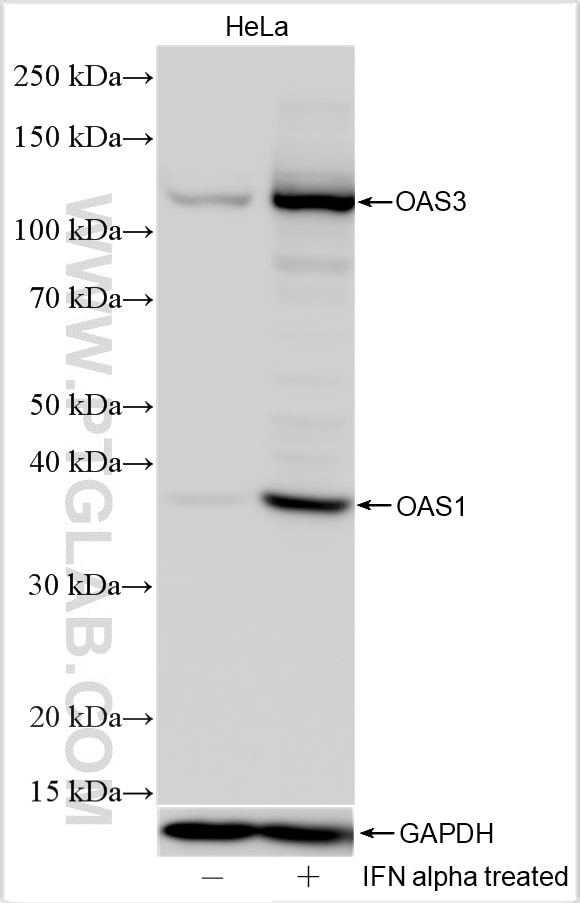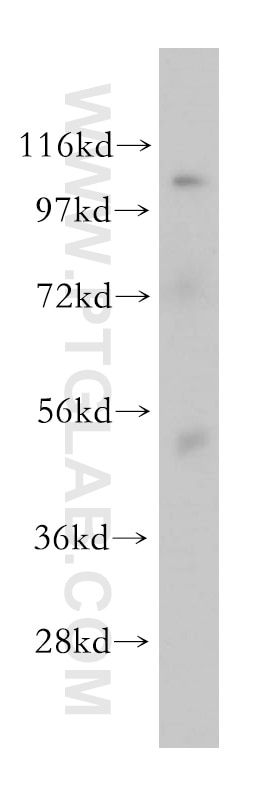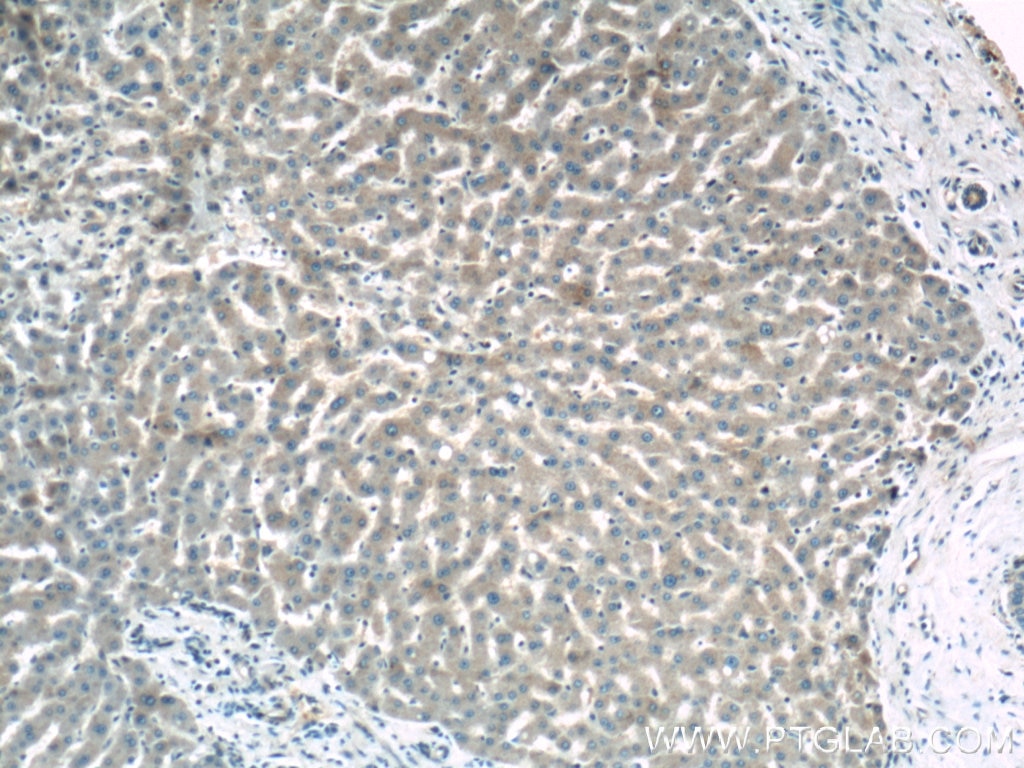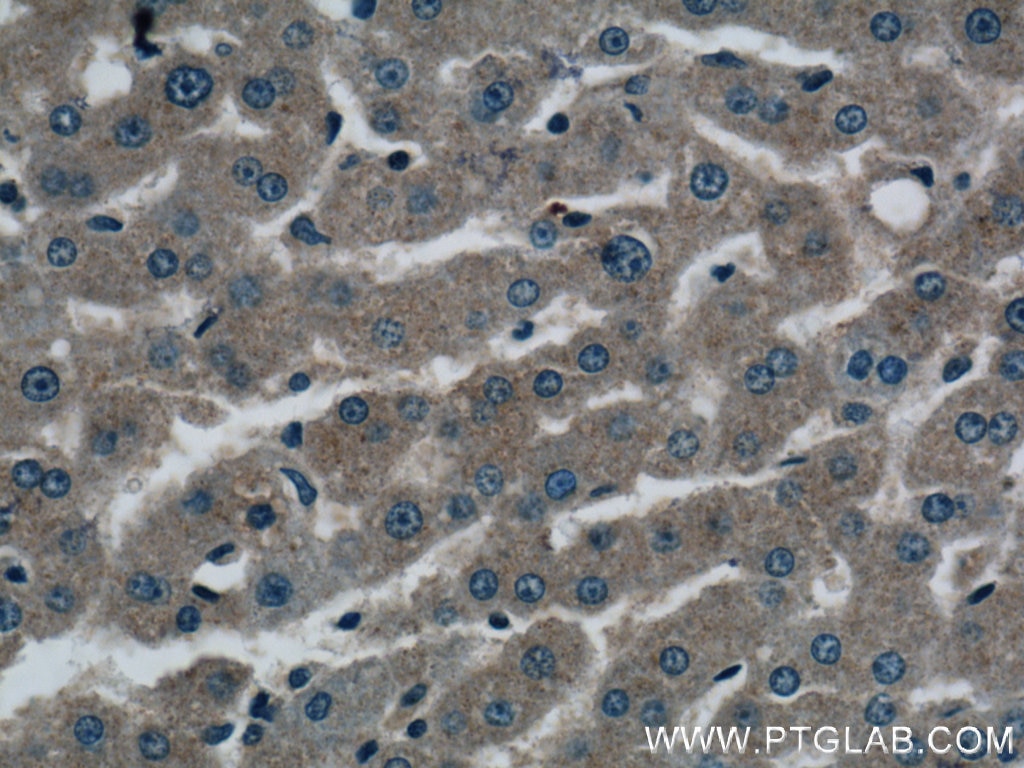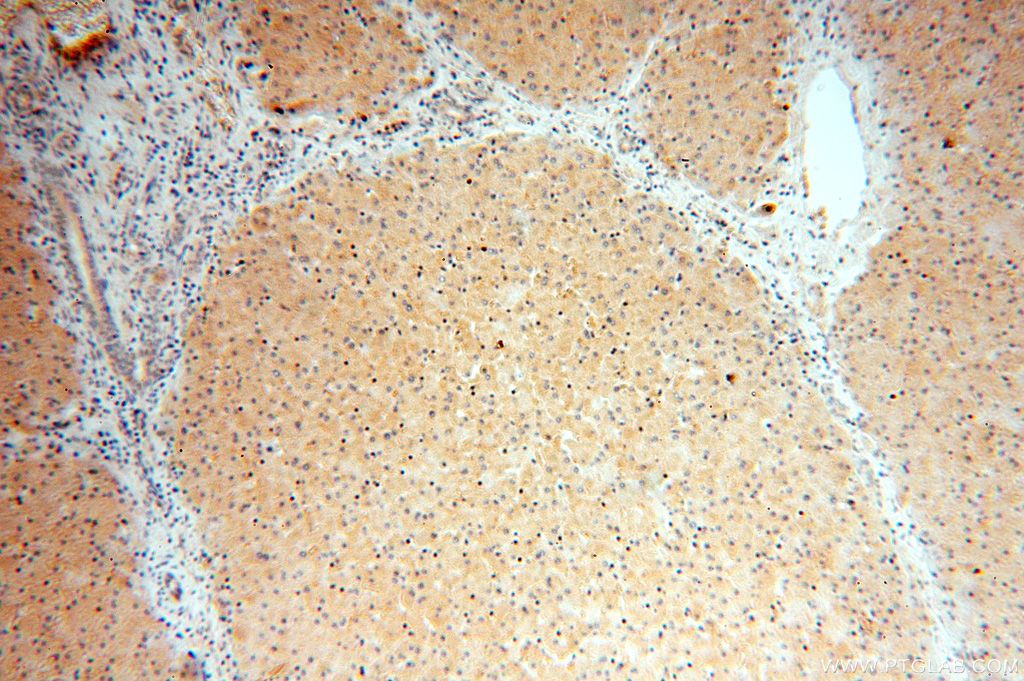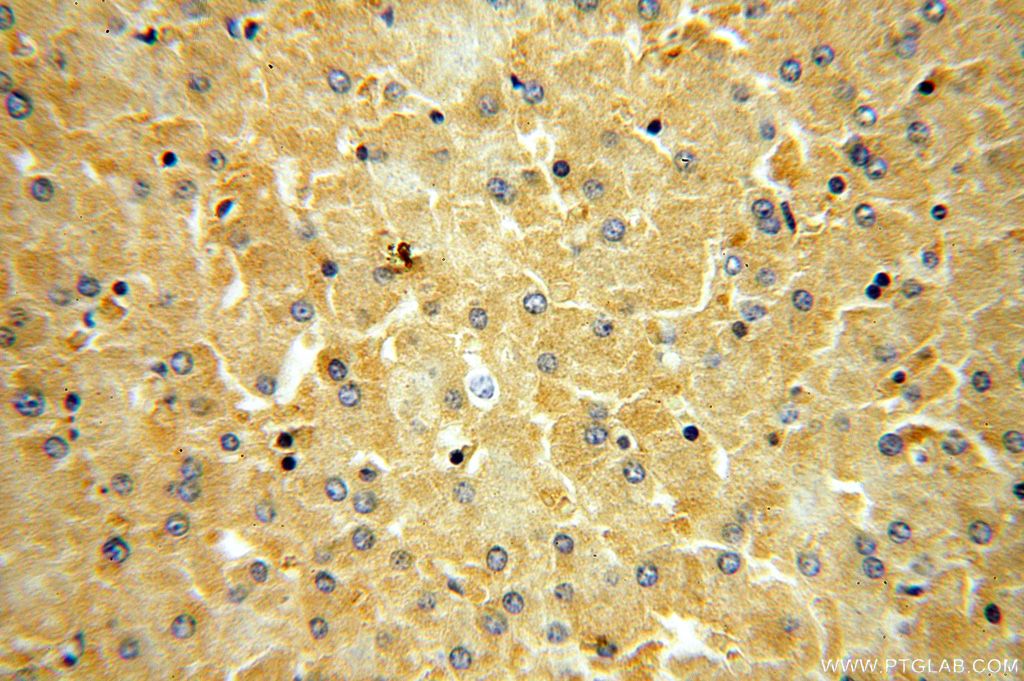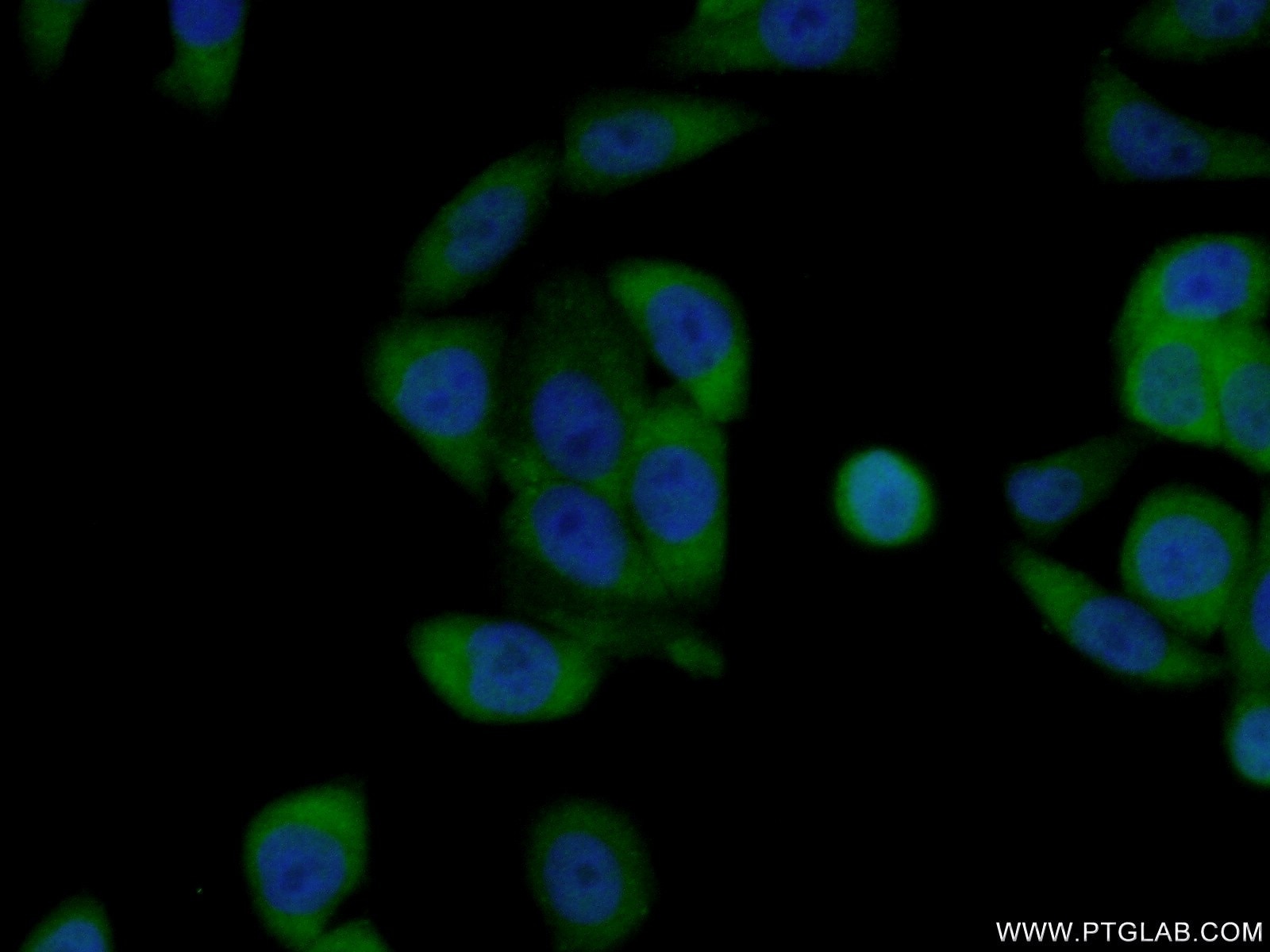- Featured Product
- KD/KO Validated
OAS1/3 Polyklonaler Antikörper
OAS1/3 Polyklonal Antikörper für IF, IHC, WB, ELISA
Wirt / Isotyp
Kaninchen / IgG
Getestete Reaktivität
human, Maus und mehr (2)
Anwendung
WB, IHC, IF, CoIP, ELISA
Konjugation
Unkonjugiert
Kat-Nr. : 14955-1-AP
Synonyme
Galerie der Validierungsdaten
Geprüfte Anwendungen
| Erfolgreiche Detektion in WB | IFN alpha treated HeLa cells, Maushirngewebe |
| Erfolgreiche Detektion in IHC | humanes Lebergewebe Hinweis: Antigendemaskierung mit TE-Puffer pH 9,0 empfohlen. (*) Wahlweise kann die Antigendemaskierung auch mit Citratpuffer pH 6,0 erfolgen. |
| Erfolgreiche Detektion in IF | HeLa-Zellen |
Empfohlene Verdünnung
| Anwendung | Verdünnung |
|---|---|
| Western Blot (WB) | WB : 1:500-1:2000 |
| Immunhistochemie (IHC) | IHC : 1:100-1:400 |
| Immunfluoreszenz (IF) | IF : 1:50-1:500 |
| It is recommended that this reagent should be titrated in each testing system to obtain optimal results. | |
| Sample-dependent, check data in validation data gallery | |
Veröffentlichte Anwendungen
| KD/KO | See 2 publications below |
| WB | See 21 publications below |
| IHC | See 3 publications below |
| IF | See 2 publications below |
| CoIP | See 1 publications below |
Produktinformation
14955-1-AP bindet in WB, IHC, IF, CoIP, ELISA OAS1/3 und zeigt Reaktivität mit human, Maus
| Getestete Reaktivität | human, Maus |
| In Publikationen genannte Reaktivität | human, Hausschwein, Maus, Ratte |
| Wirt / Isotyp | Kaninchen / IgG |
| Klonalität | Polyklonal |
| Typ | Antikörper |
| Immunogen | OAS1/3 fusion protein Ag6793 |
| Vollständiger Name | 2',5'-oligoadenylate synthetase 1, 40/46kDa |
| Berechnetes Molekulargewicht | 46 kDa |
| Beobachtetes Molekulargewicht | ~40 kDa, 100-120 kDa |
| GenBank-Zugangsnummer | BC000562 |
| Gene symbol | OAS1 |
| Gene ID (NCBI) | 4938 |
| Konjugation | Unkonjugiert |
| Form | Liquid |
| Reinigungsmethode | Antigen-Affinitätsreinigung |
| Lagerungspuffer | PBS mit 0.02% Natriumazid und 50% Glycerin pH 7.3. |
| Lagerungsbedingungen | Bei -20°C lagern. Nach dem Versand ein Jahr lang stabil Aliquotieren ist bei -20oC Lagerung nicht notwendig. 20ul Größen enthalten 0,1% BSA. |
Hintergrundinformationen
The 2-prime,5-prime oligoadenylate synthetases (OASs), such as OAS1, are interferon-induced proteins characterized by their capacity to catalyze the synthesis of 2-prime,5-prime oligomers of adenosine (2-5As). OAS1 (type I enzymes) has some isoforms with the MW of 40, 42, 44, 46, and 48 kDa (PMID:12590567, 19383565). OAS1 is a strong candidate for determining susceptibility or resistance to viral infections(PMID:15732009). This antibody may have cross-reaction with OAS3 protein due to the high homology.
Protokolle
| Produktspezifische Protokolle | |
|---|---|
| WB protocol for OAS1/3 antibody 14955-1-AP | Protokoll herunterladen |
| IHC protocol for OAS1/3 antibody 14955-1-AP | Protokoll herunterladen |
| IF protocol for OAS1/3 antibody 14955-1-AP | Protokoll herunterladen |
| Standard-Protokolle | |
|---|---|
| Klicken Sie hier, um unsere Standardprotokolle anzuzeigen |
Publikationen
| Species | Application | Title |
|---|---|---|
Adv Sci (Weinh) The CRISPR-Cas13a Gene-Editing System Induces Collateral Cleavage of RNA in Glioma Cells. | ||
PLoS Biol Resurrection of 2'-5'-oligoadenylate synthetase 1 (OAS1) from the ancestor of modern horseshoe bats blocks SARS-CoV-2 replication | ||
Autophagy USP19 (ubiquitin specific peptidase 19) promotes TBK1 (TANK-binding kinase 1) degradation via chaperone-mediated autophagy. | ||
J Invest Dermatol OAS1, OAS2, and OAS3 Contribute to Epidermal Keratinocyte Proliferation by Regulating Cell Cycle and Augment Type I Interferon-Induced JAK1-STAT1 Phosphorylation in Psoriasis.
| ||
Elife A systematic CRISPR screen reveals an IL-20/IL20RA-mediated immune crosstalk to prevent the ovarian cancer metastasis. |
Rezensionen
The reviews below have been submitted by verified Proteintech customers who received an incentive forproviding their feedback.
FH Seong (Verified Customer) (11-27-2018) | OAS1 polyclonal antibody (14955-1-AP) did work by Western Blot (1:1,500) of ARPE-19 cells induced with interferon gamma but the band was very weak in uninduced cells.
|
